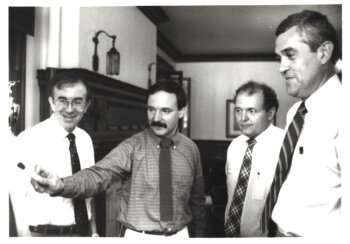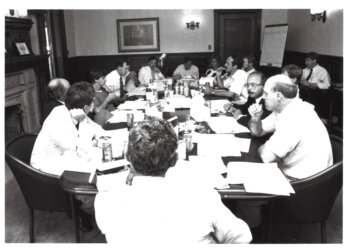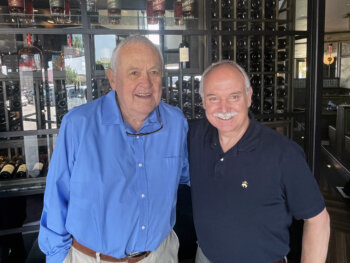40 Years of friendship and collaboration: A conversation with HCRN co-founders Pat Loehrer and Bill Fisher

Hoosier Cancer Research Network (HCRN) recently joined two of our visionary founders, Patrick J. Loehrer, MD, and William B. Fisher, MD, as they shared stories spanning their 40 years of involvement with HCRN, formerly known as Hoosier Oncology Group, or affectionately, the “HOG.”
Dr. Loehrer is Indiana University Distinguished Professor, Joseph W. and Jackie J. Cusick Professor in Oncology and Professor of Medicine, Indiana University School of Medicine; and Director Emeritus, Indiana University Melvin and Bren Simon Comprehensive Cancer Center.
Dr. Fisher recently retired from IU Health Ball Memorial Cancer Center in Muncie following a long and distinguished career in community oncology. Dr. Fisher has been a long-time champion of young investigators and clinical research staff. Through the George and Sarah Jane Fisher Fund, he established the Sandra Turner Excellence in Clinical Research Award in 2002, and the George and Sarah Jane Fisher Young Investigator Award in 2011.
On the HOG’s founding
Pat Loehrer:
 Steve Williams, Larry Einhorn, and I were having lunch at the cafeteria. I was a fellow at the time. We were chatting about how I could write a clinical trial as a fellow, but if I went on to private practice, I couldn’t do clinical trials in the community. It just seemed crazy. Then, we were talking about coming up with a cooperative group, which was when we came up with the name “HOG.”
Steve Williams, Larry Einhorn, and I were having lunch at the cafeteria. I was a fellow at the time. We were chatting about how I could write a clinical trial as a fellow, but if I went on to private practice, I couldn’t do clinical trials in the community. It just seemed crazy. Then, we were talking about coming up with a cooperative group, which was when we came up with the name “HOG.”
We called in a bunch of people from the community and had our first meeting in Emmerson Hall one Saturday. We chatted about the idea of creating this group and we got a lot of push back from some of the folks who thought we were scheming to get more patients to IU. We said, “No, it really is just to get people on trials and to be able to treat them.” It was Bill who stood up and said, “Listen, this is crazy.”
Later, as the trials went on, there were groups of people who saw reasons why they couldn’t participate; they wanted more money. Bill said, “If I can do this up in Muncie, then you can do this too.” It truly was Bill who got this group together. Otherwise, it would have just seemed like academic people trying to get people to do things.
Bill Fisher:
 It was the IU group that got us started. We couldn’t have done HOG if it weren’t for the university. Ninety percent of the trials were written by faculty at IU, and all of data management was done at IU. I think it was a model for just that reason; you could develop clinical research in communities with the cooperative work of the community oncologists and the university. Ideas and data management coming out of IU, and patients coming from the community. The patients really appreciated it, because they didn’t have to travel.
It was the IU group that got us started. We couldn’t have done HOG if it weren’t for the university. Ninety percent of the trials were written by faculty at IU, and all of data management was done at IU. I think it was a model for just that reason; you could develop clinical research in communities with the cooperative work of the community oncologists and the university. Ideas and data management coming out of IU, and patients coming from the community. The patients really appreciated it, because they didn’t have to travel.
Pat Loehrer:
At the first meeting, after we convinced them what we had to do, we came up with three studies: one was in prostate, one was in lung, and one was in colon cancer. We had no money at all, but we made a pitch to industry to do a trial with platinum and 5FU vs 5FU. At the time, platinum was running out on its patent, but the company received an extension of the patent to put more money into research. They gave us $1,000 a patient for this trial. It was a 150-patient trial, so $150,000. We gave the doctors $300 per patient enrolled on the trial, and we kept $100 in a piggy bank for the HOG. It’s crazy to think how much a trial costs today, but the doctors were happy with $300.
On the HOG’s meetings
 Pat Loehrer:
Pat Loehrer:
The HOG meetings were special. We had the best and the brightest in oncology. We had many different ASCO presidents at our meetings.
Bill Fisher:
We had fun at our meetings too. There was a lot of humor. Pat came to Muncie to give a grand rounds, and when he was done, I stood next to him and I said, “Well, we’re just a community hospital. We don’t have any money for honorarium, but we do have something special for the leader of the Hoosier Oncology Group.” One of our lab staff, her husband was a farmer, and they had a baby pig. So, she brought the baby pig wrapped in a blanket and handed it to him.”
On the HOG’s legacy
Bill Fisher:
 I look at what you guys are doing now, and wow — How many investigators? How many trials? It’s unbelievable. It started with a group of four or five of us, and now you’re exponentially bigger. That speaks volumes.”
I look at what you guys are doing now, and wow — How many investigators? How many trials? It’s unbelievable. It started with a group of four or five of us, and now you’re exponentially bigger. That speaks volumes.”
Pat Loehrer:
This is an incredible journey of friendships and relationships among the physicians, among the staff, and among the patients. It will never tire of asking questions and trying to find solutions. The HOG is at the center of that.
The beauty of the HOG, when we conceived it, was about relationships and the journey. It wasn’t as important that we had the breakthrough trials as much as us coming together and coming up with ideas and doing something. Those relationships have lasted a lifetime for me. Bill knows this, there’s nobody I love more in the field of oncology than him.
About Hoosier Cancer Research Network:
Hoosier Cancer Research Network conducts innovative cancer clinical trials in collaboration with more than 100 academic and community clinical research sites across the United States. Our studies are designed by cancer researchers from our member institutions. The HCRN staff includes 55 team members who work together to support all aspects of the studies we manage, from the time we receive the initial concept from a researcher through the final publication of the study results. Currently, we are supporting more than 70 clinical trials across a wide range of cancer types. Over our 40-year history, more than 10,000 participants in have enrolled in our clinical trials, leading to important discoveries that help cancer patients live longer and better after their cancer diagnosis.

Facebook
Hoosier Cancer Research Network on Facebook
Linked In
You Tube
Twitter